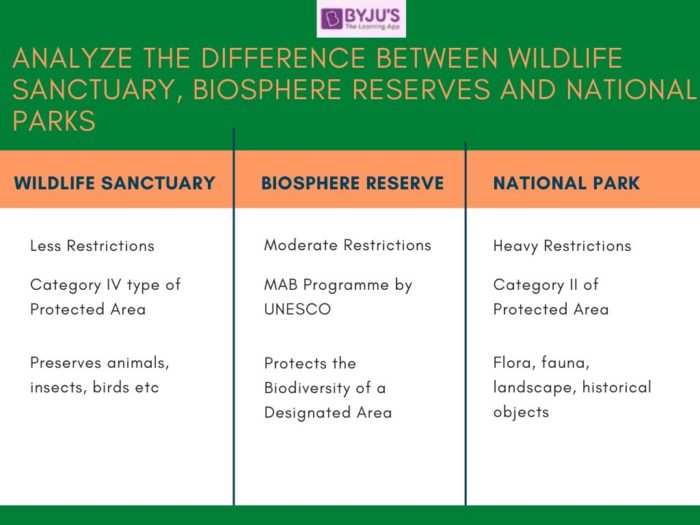Preservation of biodiversity is a must for the continued functioning of the planet as a whole. Any imbalance on account of human activity will lead to the extinction of species that are necessary for human survival. Thus, wildlife sanctuaries, biosphere reserves, and national parks are designated places for protecting wild plants, animals, and natural habitats.
A wildlife sanctuary is an area of nature owned by the government or a private agency for the protection of particular species of flora or fauna during a part of the year or in its entirety.
A national park is a reserved area of land owned by the government which is protected from industrialization, human exploitation, and pollution.
A biosphere reserve is a term given to an area for the conservation of the resources of the biosphere and the improvement of the relationship between man and the environment.

This article will further highlight the difference between the three within the context of the IAS Exam
Aspirants can find more Difference Between Articles, by visiting the linked page
The differences between a wildlife sanctuary, biosphere reserve, and a national park are given in the table below:
Differences between Wildlife Sanctuary, Biosphere Reserves and National Parks
| Wildlife Sanctuary | Biosphere Reserves |
National Parks |
| It is a natural habitat, owned by the government or private agency, that safeguards a particular species of birds and animals | A reserved area of land established by the government to protect the environment as a whole | Notified areas that cover a larger area of land which may cover multiple National Parks, Sanctuaries, and reserves as well. |
| Animals, birds, insects, reptiles, etc | Meant to preserve the biodiversity of a specified area | Flora, fauna, landscape, historical objects, etc |
| Restrictions are less and open to visitations by the general public | A typical biosphere reserve is divided into the following
|
Highly restricted, random access to the general public is not allowed |
| Not required | Subject to the particular area of the biosphere reserve | Permission is required |
| International Union for Conservation of Nature (IUCN) has defined it as a Category IV type of protected areas | It is internationally recognized within the framework of UNESCO’s Man and Biosphere (MAB) program and nominated by national governments. | International Union for Conservation of Nature (IUCN), and its World Commission on Protected Areas, has defined it as a Category II type of protected areas |
Wildlife Sanctuary, National Parks and Biosphere Reserves are covered in the Environment and Ecology segment of the UPSC Exams. Candidates can refer to the links given below will help candidates in studying this segment better:
- UPSC Environment and Ecology Notes
- Environment and Ecology UPSC Books List
- UPSC Environment and Ecology Preparation Strategy
- Biodiversity
- List of National Parks in India
Difference Between Wildlife Sanctuary, Biosphere Reserve and National Park – Download PDF Here
FAQ about Wildlife Sanctuary, Biosphere Reserves and National Park
Which is the first national park established in India?
What is the largest and smallest Biosphere reserve in India?
Candidates can find the general pattern of the UPSC Exams by visiting the UPSC Syllabus page. For more articles and exam-related preparation materials, refer to the links given in the table below:
Related Links

Comments